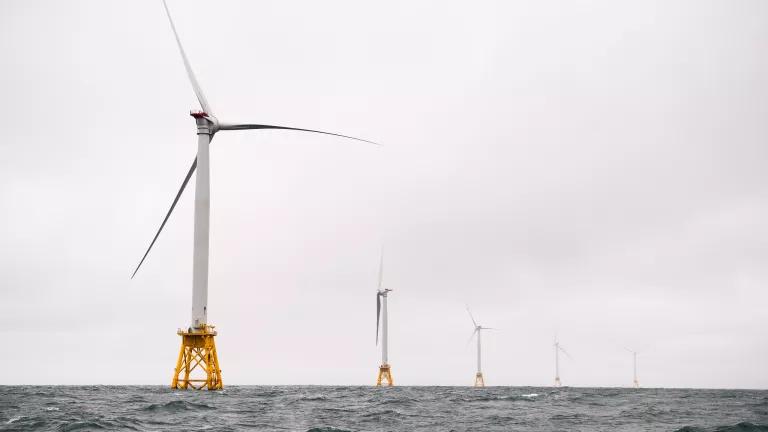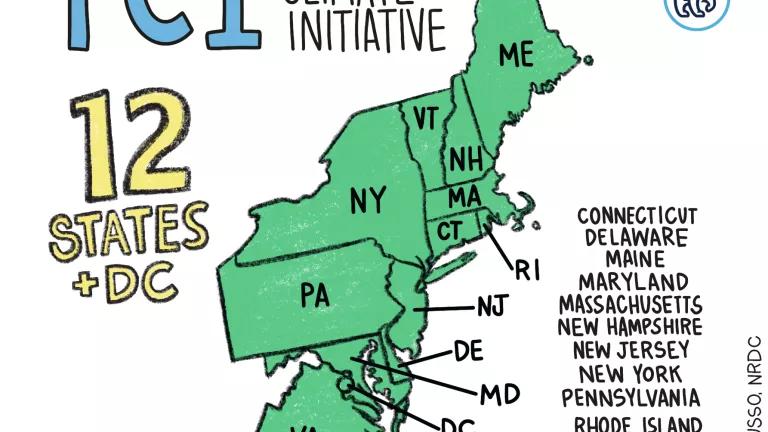Clean Energy Is Key to New England’s Fuel Security

The New England power grid is rapidly changing as energy efficiency and wind and solar power increasingly replace fossil fuels, and natural gas replaces more expensive coal and oil. On Friday, ISO New England, the organization that operates the grid in Connecticut, Maine, Massachusetts, New Hampshire, Rhode Island, and Vermont, filed comments with its federal regulator—the Federal Energy Regulatory Commission or FERC—raising concerns that reliance on natural gas could undermine the grid due to potential wintertime shortfalls in gas supply. The ISO’s “fuel security” analysis shows why the transition to pollution- and fuel-free clean energy is critical to New England’s future. Unfortunately, this is not the narrative the ISO has emphasized.
Instead, the ISO has floated a dirty energy path: paying many millions of dollars to uneconomic oil or nuclear generators not to retire, on top of its previous calls to construct new gas pipelines in the region. The ISO has presented the region’s choice in a biased way, with clean energy discounted as speculative or far off and paths relying on pipelines or bailouts to polluting energy as more reliable or certain.
Below, I explain the flaws in the ISO’s analysis and why the grid operator’s potential “solutions” would be an unwarranted step backward in New England’s clean energy transition.
The ISO’s Flawed Fuel Security Analysis
ISO New England’s comments to FERC are based on a recent analysis the ISO undertook of “fuel security risk” in the region, which it defined as “the possibility that power plants won’t have or be able to get the fuel they need to run.” The ISO looked at potential fuel challenges in the winter 2024/2025 timeframe across 23 scenarios. These include a scenario intended to represent the trajectory the grid is currently on, and a series of alternative futures. Several of the scenarios involved potential worst case disruptions, such as the loss of major gas infrastructure or an outage at a nuclear power plant for an entire winter, and looked at whether the grid could continue to operate reliably in these conditions, with a particular focus on whether gas-fired power plants would be able to access the fuel needed to run and meet grid demands. The 23 scenarios were chosen by the ISO without input from stakeholders.
Scenario analysis can be a useful tool to evaluate potential risks and opportunities if its underlying assumptions are reasonable and the analysis is presented in an appropriate context. If actions are proposed in response to the analysis, the appropriate context includes an assessment of the likelihood that individual scenarios may occur. Unfortunately, this is not the case with the ISO’s recent analysis, and there are multiple reasons to doubt the study’s results.
Problematically, the ISO’s analysis relies on assumptions about the New England grid that look very different from the grid we have today and what we reasonably expect to see in future years. This is true even in the scenario the ISO claims most represents the likely future.
In comments we recently submitted, NRDC, other environmental groups, consumer advocates, customers, and electricity generation and supply companies detailed numerous errors in the ISO’s assumptions, including its assumptions about future growth in gas and electricity demand, energy efficiency, and renewable energy, which skew the study results toward a grid that appears more susceptible to fuel security risks. Correcting these errors would likely lead to different findings, and we have asked the ISO to do so.
Even with these errors, the ISO’s study provides evidence that the region is headed in the right direction, not the wrong one. In its analysis, the ISO included one scenario with higher levels of renewable energy and other assumptions that look much more like reality. And lo-and-behold, the ISO found that if this future plays out, the grid would remain reliable. Other scenarios also showed that higher levels of fuel-free renewable energy would lower the grid’s susceptibility to fuel shortfalls at natural gas power plants.
Clean Energy’s Contributions to the Grid
The renewable energy findings from the ISO’s analysis should be front and center, particularly because higher renewable energy levels are more consistent with New England states’ policies, which call for increasing levels of renewable energy as well as energy efficiency.
Unfortunately, this is not the narrative the ISO has emphasized. While the ISO acknowledges that higher levels of renewable energy “can minimize system stress and maintain reliability” it depicts a high renewable energy future as “unlikely” and throughout its analysis, the ISO undercounts or discounts the contributions of both renewable energy and energy efficiency.
This is a problem not just in the fuel security study, but in other ISO grid planning processes as well. For several years, NRDC and others have raised concerns about ISO New England’s forecasts of future renewable energy and energy efficiency, which consistently and often substantially undervalue and under-predict clean energy resource growth. In recent weeks, for example, we have expressed concerns to the ISO that it continues to forecast less energy efficiency and solar resource growth than state policies require even though states have consistently achieved higher levels of clean energy faster than expected.
While the ISO has made some recent improvements in its forecasting, the fuel security analysis does not fully capture these improvements, and other concerns remain.
Continuing its history of discounting state policies, the fuel security analysis scenario that the ISO claims depicts the likely future includes only 6,600 megawatts of renewable energy capacity in 2024/2025—far below the more than 8,000 megawatts needed to achieve state renewable portfolio standards.
The analysis also fails to account for even current levels of clean energy. New England already has more than 1,300 megawatts of onshore-wind, yet none of the ISO’s fuel security scenarios includes more than 1,200 megawatts by the year 2024. Even the ISO’s “maximum renewables” case has less on-shore wind than we have today.
Additionally, the ISO did not consider the potential deployment of energy storage technologies in the coming years that could further integrate renewable energy and address peak demand. Massachusetts, for example, has mandated at least 200 megawatt-hours of new energy storage be installed by 2020, well within the ISO’s 2024/2025 study horizon.
Potential Solutions and the Likelihood of Risks
There are other problems as well. The ISO characterizes its analysis as demonstrating the grid’s vulnerability. Yet the ISO has not even attempted to assess the likelihood of any of the scenarios it evaluated. Many appear to involve worst case conditions that have never occurred. Evaluating such scenarios may be worthwhile, but the fact that worst case scenarios in the study produce largely negative results is not in and of itself a meaningful assessment of grid vulnerability.
In its grid resilience docket, FERC requested that ISO New England and other grid operators explain how they “assess the impact and likelihood of resilience risks.” For the fuel security analysis to be useful, the ISO must evaluate how likely different potential grid futures are to occur. Assessing the likelihood of risks is necessary to understand grid risks and is also key to understanding whether potential solutions—and the costs of achieving them—are reasonable.
A balanced assessment of fuel security must also consider the potential for higher levels of growth in clean energy efficiency and renewable energy to address fuel security challenges. While the ISO considered some mitigating conditions, because the analysis largely revolves around a future that looks so different from where the grid is headed, it remains deficient.
A flawed and imbalanced study and presentation of fuel security risks by the ISO also sends incorrect signals to the states about the value of renewable energy and energy efficiency. Already, the ISO’s study has been used to justify a potential bailout of nuclear power in Connecticut in the name of “fuel security,” despite a lack of data showing the nuclear facility is at financial risk.
Ultimately, to the extent the ISO’s fuel security analysis proves anything, however, it is that continued deployment of clean energy will improve grid reliability and reduce fuel security risks. Heading instead toward more expensive and polluting energy and a possibly unreliable gas buildout could increase fuel insecurity, would unjustly and unreasonably raise costs in the region, and would exacerbate the dangers of climate change.



